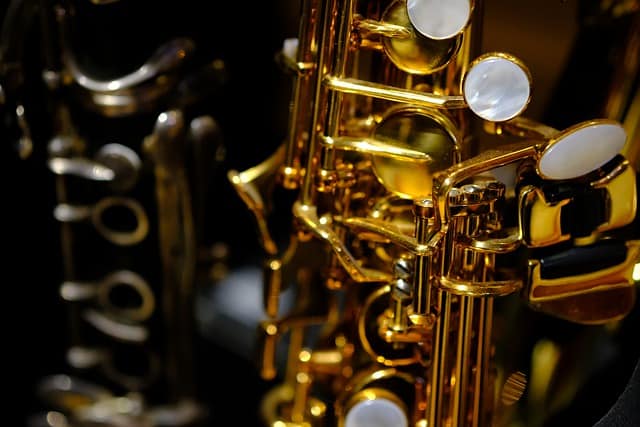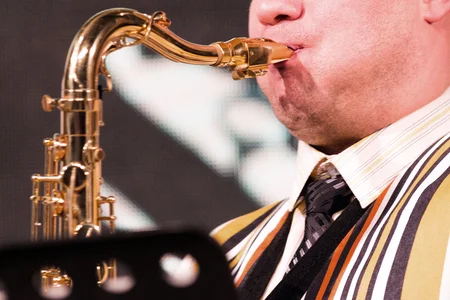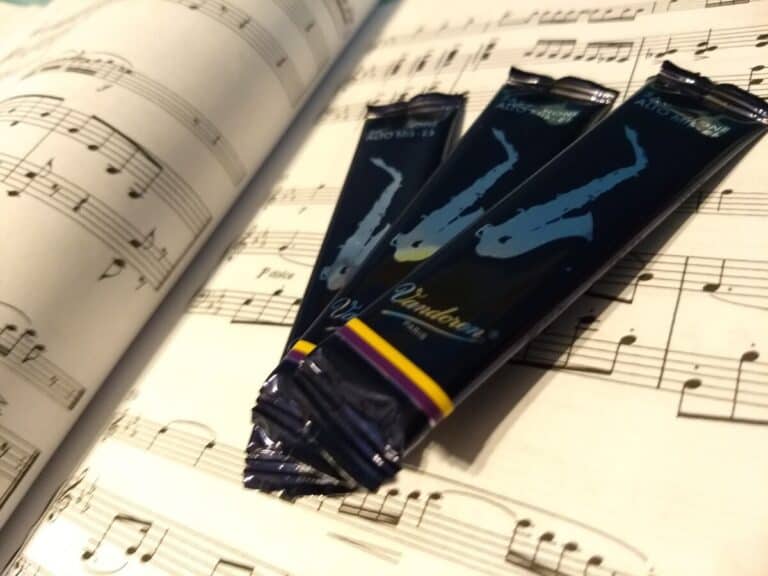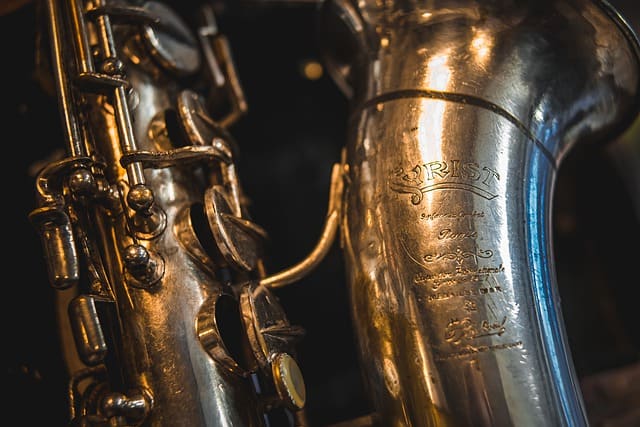Clarinet vs Saxophone: A Complete Comparison
To the person who isn’t experienced with woodwind instruments, the clarinet and the saxophone can seem like they might as well be the same instrument. My goal is to clarify the differences between them, discuss the unique difficulties of both of the instruments, and help the potential beginner gain a better idea of which one they would prefer to play.
Key differences
In short, the difference between the saxophone and the clarinet is that the saxophone has a conical bore (that is, the instrument is wider toward the bell) while the clarinet has a cylindrical bore (where the width of the tubing is constant). The different bore shapes cause the saxophone and clarinet to have different fingerings and sound characteristics.
The shape of the bore changes nearly everything about an instrument. As such, the mere fact that the saxophone becomes wider toward the bell while the clarinet does not makes the instruments very different in practice.
Different fingerings
One of the upshots of the difference in bore shape between the clarinet and saxophone is a change in fingerings. Both the saxophone and the clarinet have octave keys, but the clarinet octave key makes the pitch jump up a twelfth while the saxophone octave key only makes the pitch jump up an octave.
The result of this is that the upper register (while pressing the octave key) of the clarinet and saxophone have the same fingerings, but the lower registers have different fingerings. Specifically, the fingerings for the saxophone’s lower register are identical to those of its upper register, but the clarinet’s lower register differs from its upper register.
In practice, this means that saxophonists have a few less fingerings to memorize, since their lower register is just a repeat of their upper register. This also means that it is much easier to switch from clarinet to saxophone, because the saxophonist will have to learn additional clarinet fingerings while the clarinetist will already know most saxophone fingerings.
Different sounds
The color of the sound that an instrument produces is one of the distinguishing factors that makes an instrument unique. While you might think that the material that an instrument is made out of is the primary factor in determining the sound, the kind of bore that an instrument has is possibly a more important factor.
The saxophone, with its conical bore, tends to produce a sound that can mimic a string instrument or a brass instrument depending on the equipment and the context (classical or jazz) that the musician is playing in. This differs from the clarinet, which tends to have a mellower and reedier sound.
Also, the saxophone in general tends to project its sound better than the clarinet. As the size of the bore increases, so does the ability of an instrument to play loudly.
It isn’t particularly helpful to have me just describe the sound of these two instruments, though. It would be much better for you to actually listen to solos which feature these instruments. If you don’t have a good sense of what these instruments sound like and aren’t sure what to listen to, try listening to each of these pieces:
Classical Clarinet: Mozart Clarinet Concerto, Von Weber Clarinet Concerto No. 1
Classical Saxophone: Concertino da Camera, Glazunov Saxophone Concerto
Jazz Clarinet: Artie Shaw Clarinet Concerto
Jazz Saxophone (albums): “My Favorite Things” by John Coltrane “Saxophone Colossus” by Sonny Rollins, “Something Else” by Cannonball Adderley
Ease of the extreme low register
One result of having an instrument with a conical bore is that it becomes more difficult to play as you get lower in the range of the instrument. So, if you are playing the saxophone, you will find that there is much more resistance on the lowest notes of the instrument than there is in the instrument’s middle range.
The clarinet has virtually no difficulties in the lower register. This is one of the advantages of having a cylindrical bore as opposed to a conical bore. Since a conical bore requires the air to fill up the full width of the instrument, playing in the lower register requires much more air and is more likely to crack into the octave above.
Open vs closed holes
One other key difference is that the clarinet uses open holes while the saxophone uses closed holes. This means that a clarinetist must be diligent to ensure that their fingers completely cover the holes, otherwise the instrument will likely squeak. The saxophonist has no such limitation, though it is still good practice for the musician to ensure that the pads of their fingers are centered on the keys.
The fact that the clarinet uses open holes is one reason why the clarinet is often said to be slightly more difficult than the saxophone for beginners. Ensuring that the holes are covered takes a small amount of extra diligence.
Which is more challenging?
The clarinet tends to be more difficult to play than the saxophone for beginners. The clarinet has more fingerings to memorize, open holes to cover, and overall more challenging technique. The combination of these can make the clarinet intimidating to newer players. In the long-run, the two instruments are about equally difficult to master.
Clarinet has more fingerings to memorize
As we talked about earlier, the fingerings for the lower octave of the clarinet are different from the fingerings for the upper octave. Since this is not true for the saxophone (where the fingerings are the same for the upper and lower octaves), this means that a beginning clarinetist will have to memorize more fingerings.
This isn’t necessarily an immense struggle, but it is nonetheless a challenge for a beginner who might already be overwhelmed with the large number of skills required for learning an instrument.
Clarinet has open holes
One difficulty in playing an instrument that has open holes is that the slightest misplacement of one finger can cause the instrument to squeak or otherwise cause the note to crack.
For this reason, beginning flutists often play on flutes which have closed holes, even though most flutes at the professional level are open-holed. The clarinet, however, is never close-holed, even on a beginner instrument.
It takes practice and attention to one’s hand position in order to navigate an open-holed instrument properly. The benefit of this is playing clarinet will force the musician to use proper hand position out of necessity. On an instrument such as the saxophone, it is easy to develop bad habits such as using straight fingers, or not positioning one’s fingers properly on the keys.
Different intonation tendencies
In general, the clarinet is more difficult to tune initially, while the saxophone is more likely to go out of tune on a dime.
Most clarinet notes naturally seem to have different intonation tendencies, so the clarinet typically involves more initial adjustments than the saxophone.
However, the fact that saxophone is made of metal means that it expands and contracts as the temperature changes. This means that you will need to make more adjustments as you are playing.
Other skills
The clarinet is known for the notorious “break”, which refers to the finger movement required between the notes A# and B-natural. Moving over the break requires the clarinetist to move nearly all their fingers at the same time, which one a woodwind instrument is inconvenient and often causes notes to crack. Since the saxophone has no equivalent of this, the clarinetist will need to put particular emphasis on playing scales in order to get a grasp of playing over the break.
The saxophone certainly has its own challenges for beginners to put up with, but in general they are not considered to be of equal magnitude to the challenges which the clarinet poses. The saxophone is resistant specifically in the lower register due to its conical bore, whereas the clarinet has no issues in this department. Even so, the closed holes of the saxophone and lack of a “break” makes the saxophone an easier instrument to play overall.
Which one should I play?
What instrument you decide to play should depend largely on what you enjoy listening to. One of the best things you can do when deciding what to play is to listen to how professionals play the instrument you are potentially interested in. If you are stuck between saxophone and clarinet, then listen to solo literature for both. The music recommendations I gave above are staples of classical and jazz literature for those instruments, so you may end up one day playing some of those pieces depending on the instrument that you pick.
Also keep in mind that opportunities for clarinetists are typically different from the opportunities for saxophonists. For instance, saxophonists are always needed in jazz bands, so if you are looking to play jazz then saxophone is probably the better starting point. Clarinets may at times be present in jazz bands, but will only be played in those settings by someone who is also playing saxophone. If you want to play jazz music, it is fine to learn clarinet, but at some point you will probably need to learn saxophone as well.
One of the main appeals to playing the clarinet rather than the saxophone is the possibility of playing in orchestras. Saxophones are almost never used in orchestras, while clarinets are needed frequently. So, if you are highly interested in playing primarily classical music, clarinet may be worth considering. At the very least, it may be worth learning saxophone with the eventual intent of learning clarinet.
If you care about the difficulty of the instrument, then you should know that clarinet will be a little bit more challenging at first, but in the long run the difference in difficulty between the two becomes negligible.
Should I learn clarinet before saxophone?
It is not strictly necessary to learn clarinet before saxophone. In fact, it probably isn’t worth doing so at all if clarinet isn’t an instrument that you are passionate about. Practicing is of absolute importance when playing an instrument, so you should play whatever it is that you will be most motivated to practice.
If you don’t mind picking up the clarinet first, though, there certainly are benefits to doing so. The embouchure of the two instruments are not exactly the same, but playing clarinet will ensure that you use proper hand position, while playing the saxophone allows for bad habits to emerge early on.
Also, once you know clarinet, you already know almost all of the fingerings for saxophone. So, it isn’t difficult to switch from the clarinet to the saxophone, and you won’t miss out from learning the clarinet first.






